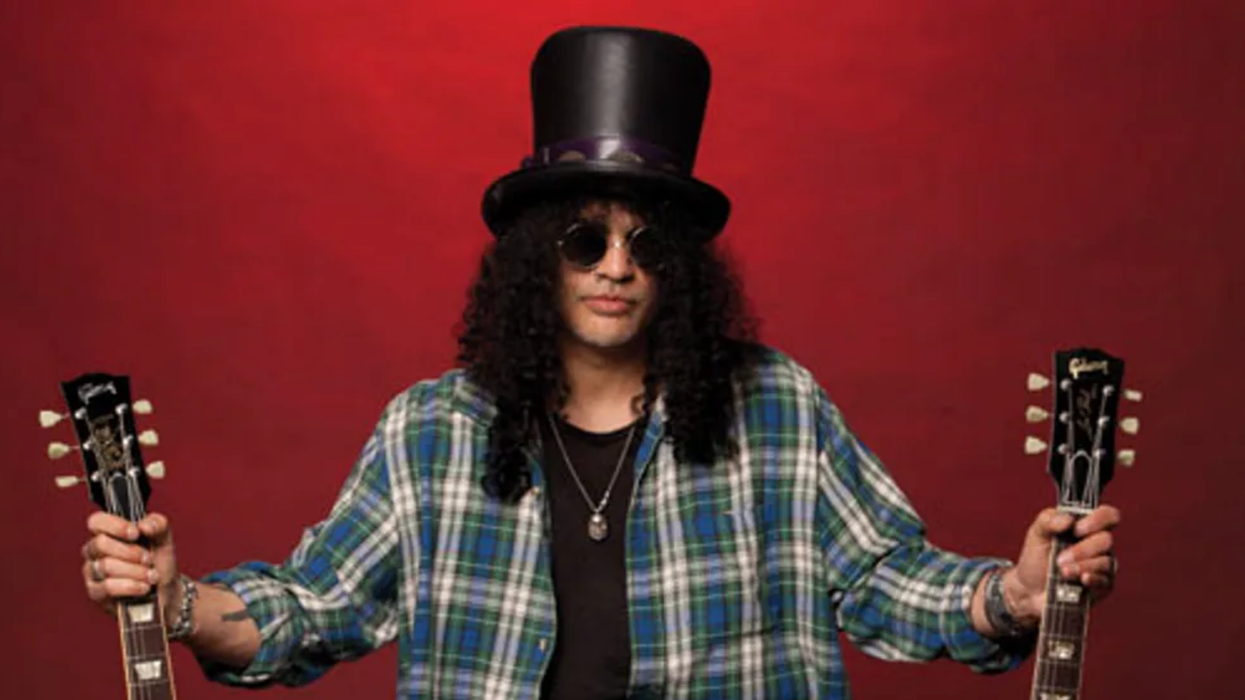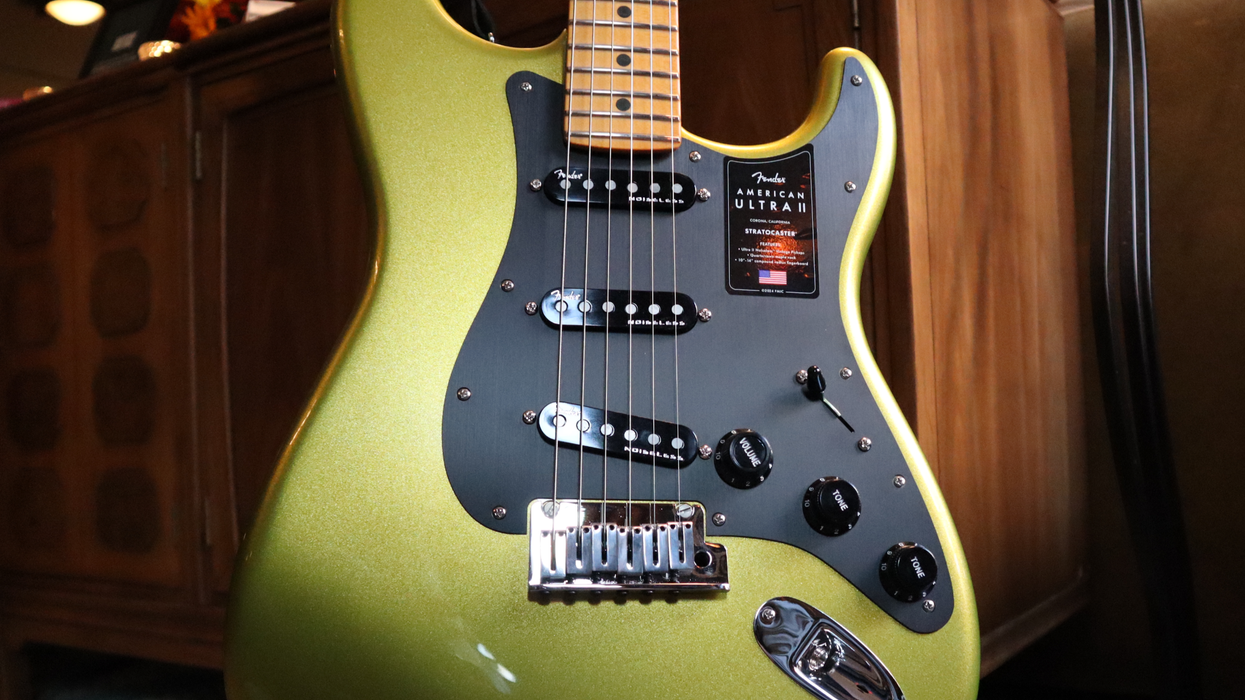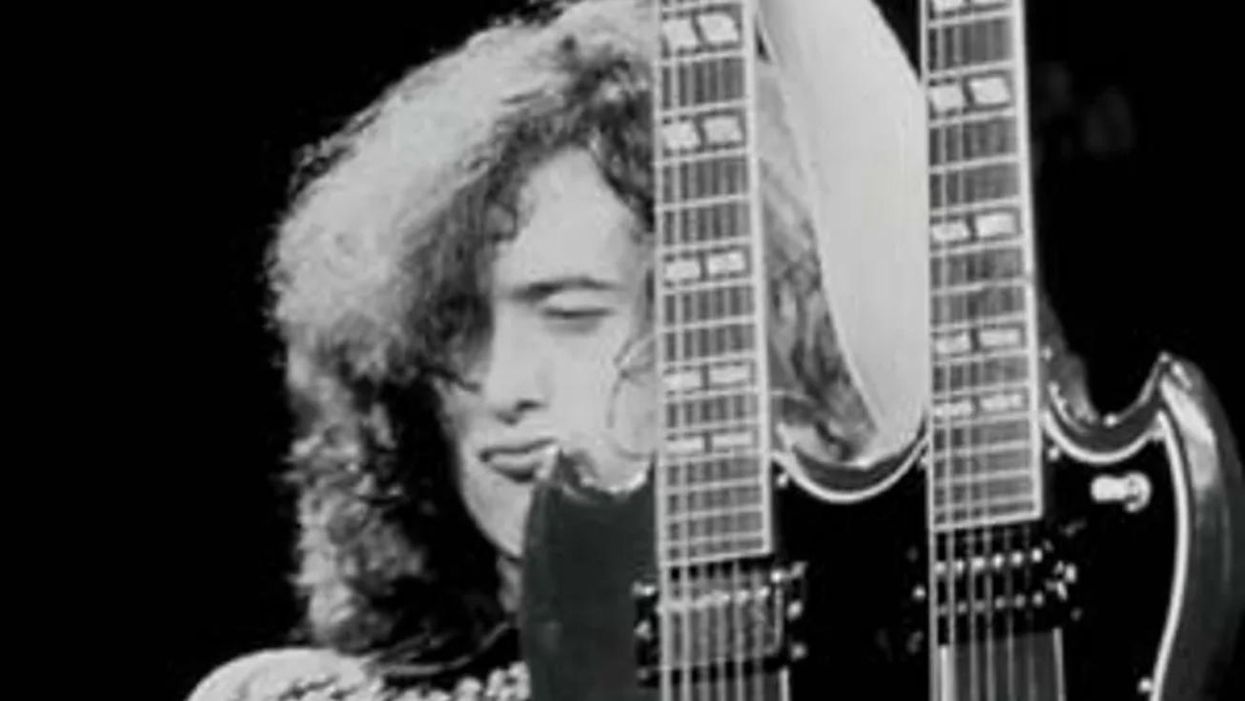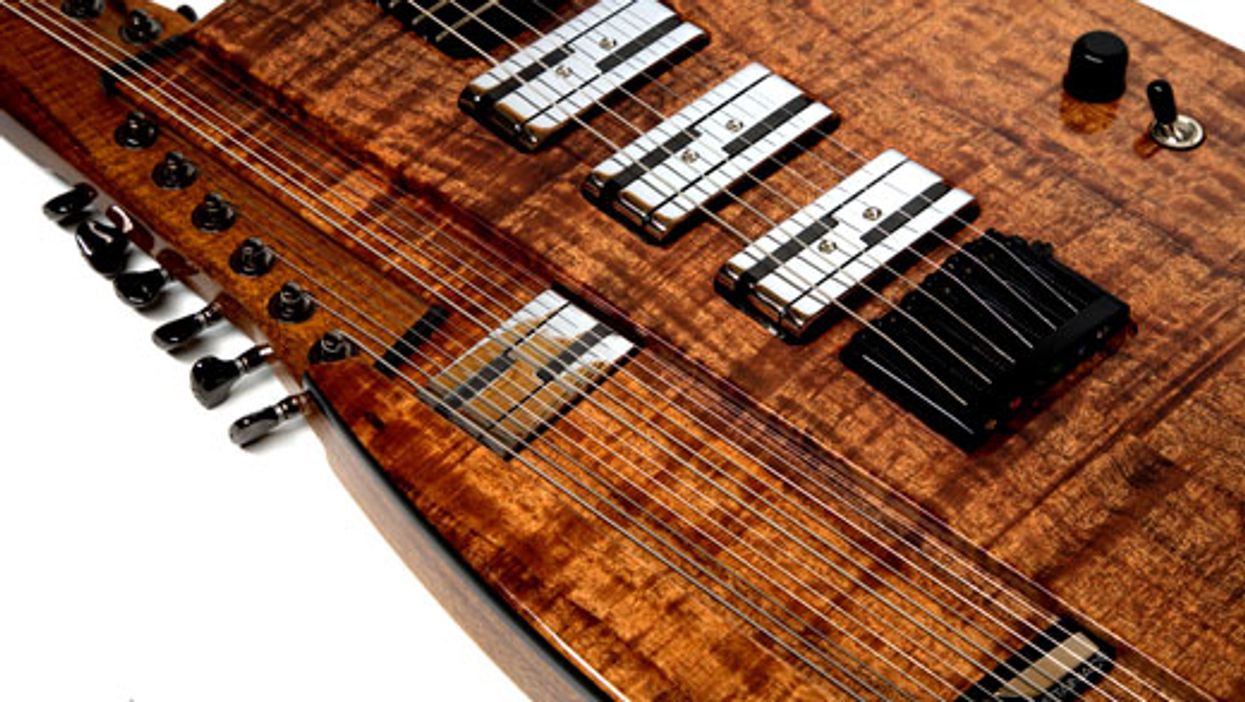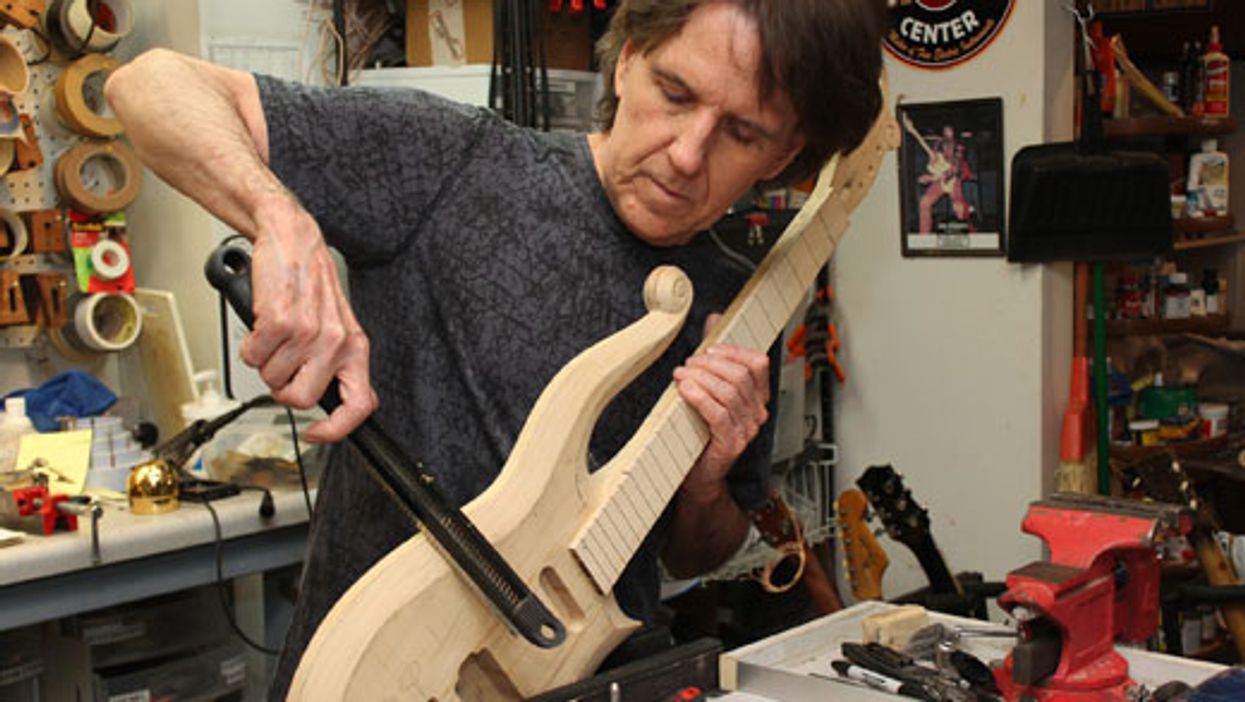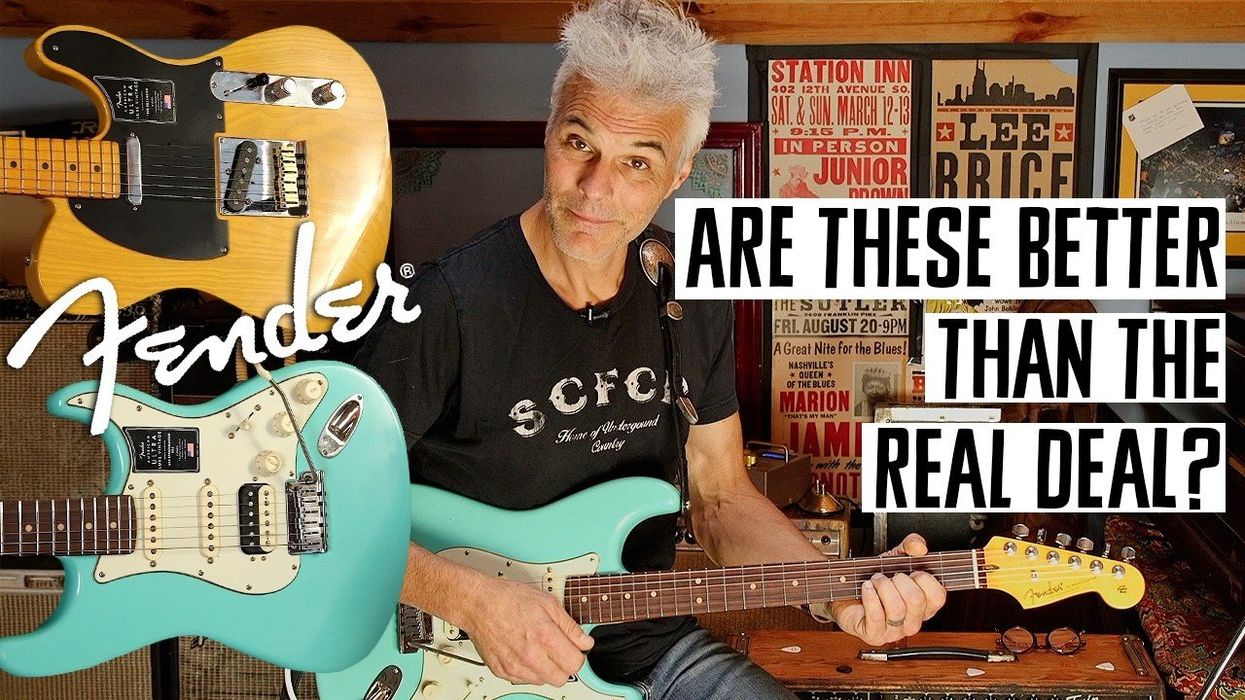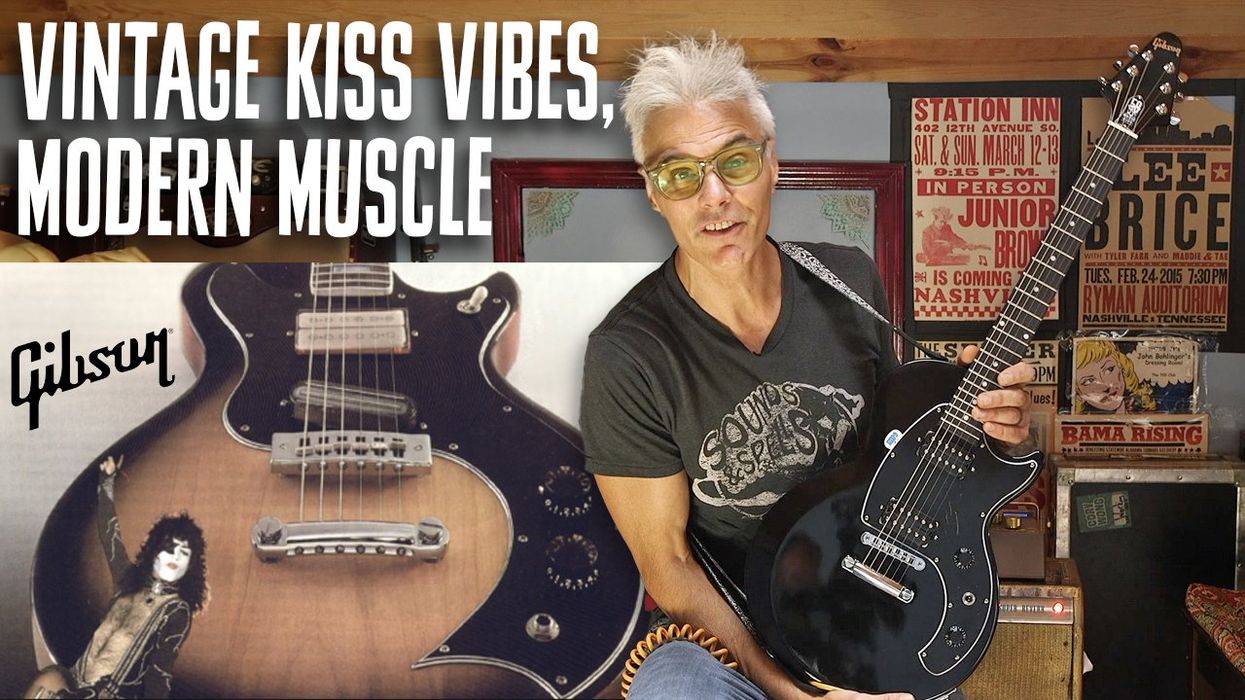Mythology is an essential part of human life. We may not spend much time discussing winged-footed Greek gods or tales of dragonslayers while we tune our guitars and haul amps into clubs. But myths and legends are still all around us. From the triumph of the Jedi in the Star Wars films to the latest heroic act on the sports field, myths inform our culture and sense of belonging. And even within a musical context, certain stories take root, grow, expand, mutate, and are shared for generations until they reach legendary proportions.
The story of Slash's instrument arsenal during the heady days of recording Guns N' Roses Appetite for Destruction is just such a tale, retold by our era's version of epic poets and debated as hotly as any controversial archaeological discovery.
In March 2010, Gibson Guitars released their Slash Appetite Les Paul model. The company's press materials proclaimed this was "the axe that launched a thousand riffs." In videos hosted on the Gibson website, Slash holds the new model next to his personal guitar and says, "This is the original right here," and "It's basically set up just like my original was." The camera slowly pans over the instrument and zooms in on some of the details.
"All things considered, with the original one, it just happened to have a certain sort of unique tone unto itself," Slash says in the video. "With the new one, we basically tried to capture that. The new Appetite for Destruction guitar is about as close as anybody could get to the original."
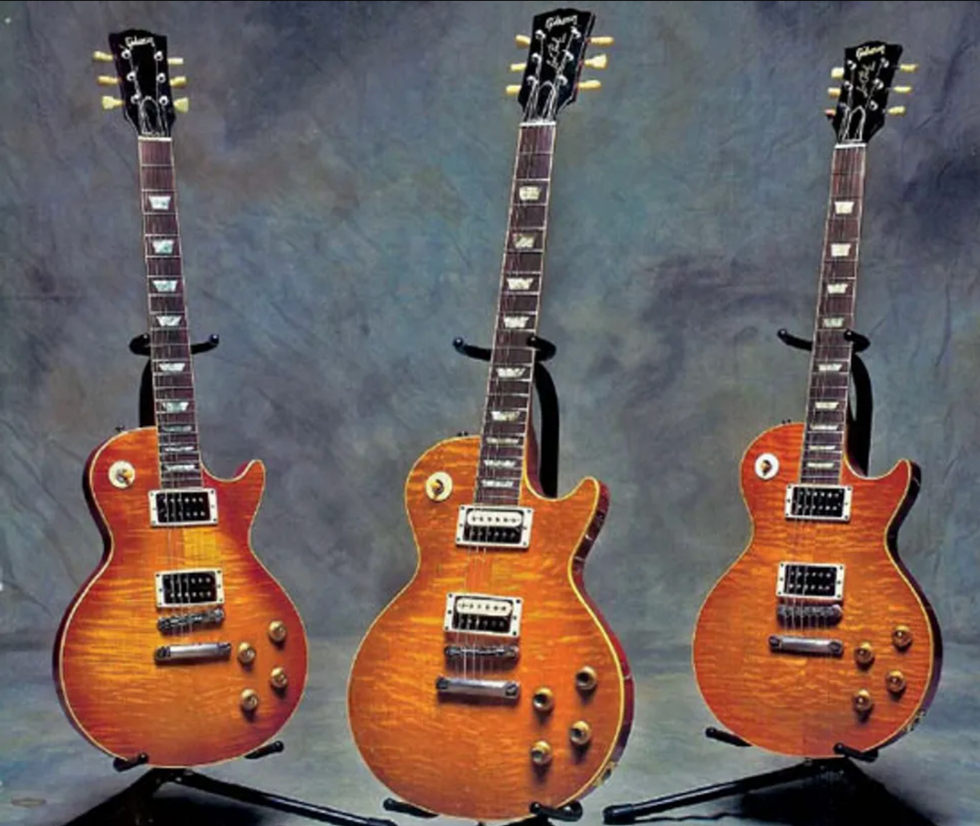
According to luthier Roman Rist, the middle Les Paul replica here is Slash's first from luthier
Kris Derrig—the one Rist says Slash used on the tail end of Appetite. The guitar on the right
was built by Peter "Max" Baranet. The instrument on the left is purportedly Slash's second
Derrig model.
Photo courtesy of Roman Rist
The guitar was hailed as an impressive instrument. When Premier Guitar reviewed it, we said, "It's a well-built, high-quality Les Paul with flawless playability and gorgeous looks." The review carried a 4.5 rating out of a possible 5.
That review also pointed out something that Slash fans and internet forum users had known all along: The Slash Appetite Les Paul is actually a replica of a replica— because the instrument Slash rocked on the iconic album wasn't actually a Gibson. The "original," as Slash calls it in the videos, was made by California luthier Kris Derrig.
Slash and Gibson did not respond to interview requests for this article. However, we should note that the general attitude among savvy guitarists is that Gibson's Appetite Les Paul isn't some attempt to hoodwink an unsuspecting public. Most observers feel that if a customer is a big enough fan to pay the list price of nearly five grand for the instrument, they'd also know the true story. And Gibson's new Appetite guitar does include some modern updates that theoretically improve its practicality for a mass audience. And in many ways the Gibson initiative to sell such an instrument addressed a burgeoning demand among consumers—and addressed it well.
"I don't fault them at all," says guitar builder Roman Rist, who figures into the earlier days of this tale. "Slash does have a relationship with Gibson. Slash is a bona fide rock star, and, for them, why not make a Slash model? I'm sure Slash had plenty of input in the design to be able to sign off and be happy with the guitar. I don't see anything wrong with it."
But while Gibson rehashed the iconic instrument for today's musician, the larger legend is much more complex. Indeed, there are many who allege Slash actually wielded three Les Pauls during the time in question. Those three guitars are shrouded in questions, contrasting memories, and conflicting reports. Examining the legend of these instruments is like trying to unravel the threads of an ancient Norse epic or documenting the numerous trysts and offspring of the Greek god, Zeus. Each answer opens a new question, each thread ends at the beginning of a new one.
The Epic of the Hunterburst
Mythologist, lecturer, and writer Joseph Campbell focused on the role mythology plays in the human experience, while examining myths and legends handed down through the centuries. There are certain constants that appear in myths, regardless of the culture that spawned them. There is a hero who must leave his comfort zone and embark on some sort of journey. Along the way, that hero encounters supernatural help in the form of "amulets," quoted in the Campbell passage above. The form of these implements changes throughout the myths. It could be King Arthur's Excalibur, or Perseus's gifts from the gods, or Luke Skywalker's lightsaber.
Or, in a musical context, the mythological structure could feature an impoverished, curly-haired hero encountering a transformative instrument.
In the early '80s, during Guns N' Roses' formative period, Slash was living hand-to-mouth. Struggling to eat and pay for a drug habit, he certainly lacked the wherewithal to accumulate fine vintage instruments.
"Those guys couldn't put two nickels together to buy a pack of Marlboros back then," says former Guns manager Vicky Hamilton. At the time, Hamilton even allowed the nascent rockers to move into her apartment— which surely diminished the likelihood of recovering her security deposit.
Due to such constricting finances, Slash played a variety of guitars during this period, as documented in Marc Canter's photography book Reckless Road: Guns N' Roses and the Making of Appetite for Destruction, and he was certainly not tied to any particular brand.
Throughout that text are photos of Slash with a red B.C. Rich Warlock, a B.C. Rich Mockingbird with visible wood grain, and—when he was very young—even a black Fender Stratocaster. In Slash's own best-selling memoir, Slash, written with co-author Anthony Bozza, the guitarist relates a story of asking Kiss' Paul Stanley for help procuring instruments from B.C. Rich.
It was in that wilderness of instrument experimentation that Slash came across the first amulet that would help him face the challenging climb up the ladder of rock 'n' roll stardom.
"I was playing a new guitar," Slash writes in his memoir. "It was a Les Paul that had belonged to '70s blues guitarist Steve Hunter. I'd traded my B.C. Rich for it at Howie Hubberman's place, Guitars R Us."
Obtaining this instrument was a major cause for celebration at the Guns base camp.
"I have one really good memory of Slash getting his first sunburst Gibson, and he brought it into our living room when we were all living together," says Hamilton. "He opened the case with pride and everyone gave him the 'ooh' and 'aah.'"
That guitar is frequently referred to as the "Hunterburst," after its former owner who was famous for performances with Alice Cooper, Peter Gabriel, Lou Reed, and even Aerosmith. Perhaps most notably, Hunter played on the Cooper tunes "Billion Dollar Babies" and "Welcome to My Nightmare," as well as Gabriel's "Solsbury Hill" single and Lou Reed's epic Rock n Roll Animal.
The problem is that Hunter doesn't know if his guitar ended up in Slash's hands. Though the influential guitarist politely declined to speak on the record for this interview, he did state he does not know what happened to his instrument after he sold it.
Guitar gurus Hubberman and Rist both handled Hunter's Les Paul and are certain the guitar went to Slash. The instrument came into the shop with original '50s parts, including PAF pickups that were ultimately removed to sell on the vintage market while the guitar was retrofitted with more modern, reasonably priced hardware.
"I put the Seymour Duncans in," Rist says. "I worked on setting it up and getting it to play good. It stayed there for maybe a couple of days. So maybe a couple of days later, Howie calls up Slash saying, 'I got the guitar for you.' Slash comes in and they work out some kind of deal."
Hubberman, who was also an early investor in the band, recalls that he sold the instrument to the young gunner for $2600, payable over time. "You know, they didn't have any money back then," Hubberman says. "I would just give things to them off the cuff and they'd catch up to me later down the line. Those guys always took care of me. Izzy [rhythm guitarist Izzy Stradlin] was probably the brokest of the bunch, but he would pay it off. Same thing with Slash. I mean, it took a couple of years for Slash to pay off that guitar, but he paid it off."
Humorously, Hubberman adds, "I think when he paid it off, he no longer owned it."
Legend and innuendo has it that Slash pawned the so-called Hunterburst to pay for his drug habit. While that can't be proven, it's certainly possible. In his memoir, the guitarist writes of times when "I sold my equipment for cash to score more smack."
Peter “Max" Baranet—the Man Behind the Hunterburst?
Rist argues that the Hunterburst, although not played on Appetite for Destruction, deserves a significant place in rock 'n' roll history.
"The Hunterburst carried a lot of weight because it was owned by a rock star who, in my opinion, had contributed greatly to the music scene," Rist says. "Steve Hunter is the real deal. So here's the guitar that went from the old guard to the new guard. That's the one that got him [Slash] hooked. The seed for his Les Paul addiction, becoming the Les Paul icon that he is, is the Hunterburst."
But, as was mentioned previously, the Hunterburst wasn't a Gibson. It was a replica. Steve Hunter says it was built by luthier Peter "Max" Baranet, who friends and clients typically refer to simply as Max. Howie Hubberman says the instrument was built by Baranet. So does Roman Rist.
Baranet himself? He's not so sure. In written statements and telephone interviews, Baranet won't confirm or deny that the Hunterburst is one of his instruments.
"Yeah, I don't remember it," he says. "There's people that remember it being in my shop and stuff. But there was a lot of stuff going on in those days, you know. A lot of guitar building and a lot of people running through."
The volume of Baranet's work was indeed staggering. "One year that I was at Image Guitars, I had assembled or custom made over 150 guitars," he recalls. "Singlehandedly. So, you know what I'm saying— [it's] one single guitar. I'm not going to remember everything."
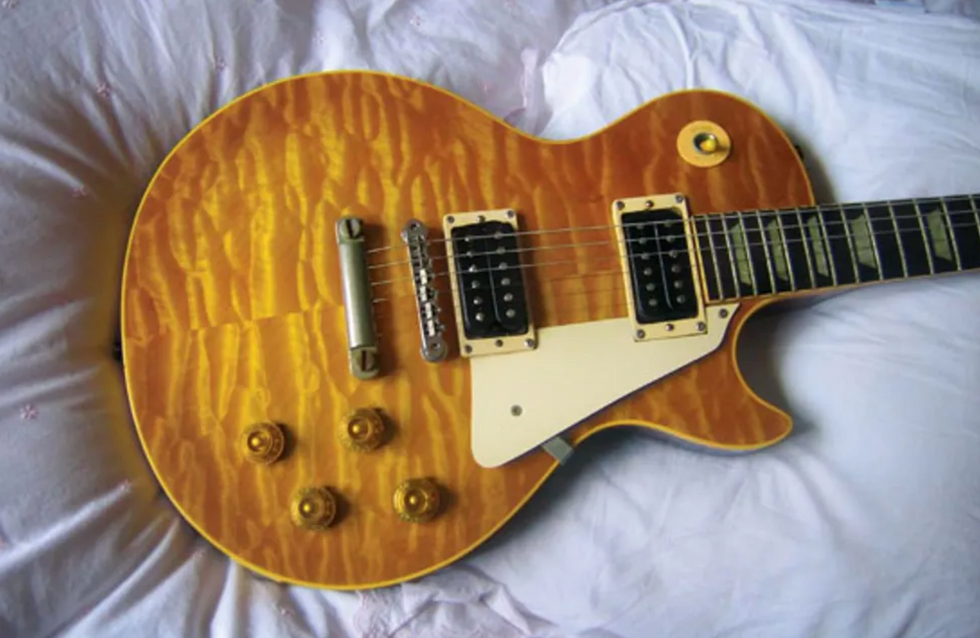
This Les Paul replica commonly referred as "Hunterburst" (because it had been previously owned by Alice Cooper guitarist Steve Hunter) was reportedly Slash's first brush with a quality copy of Gibson's iconic guitar in and around the Appetite for Destruction period.
Photo by Mark Olson
Serial numbers and markings for replica instruments of the day were not standardized and provide little help in solving the mystery. Baranet says he sometimes used customers' birthdays, sometimes even Social Security numbers and other combinations of digits.
Despite Baranet's reluctance to claim the Hunterburst, his former colleague Rist is convinced Baranet built it.
"I worked with Max so long I know how he does things," Rist states. "There are certain little trademark things I can use to spot a Max from a mile away. There are other trademarks with the way he does his routing. If I open it up, I can go, 'Yep, this is a Max.'"
. . . Enter Kris Derrig Version
Whatever the lineage of the Hunterburst, at some point it passed out of Slash's hands. In general, the band had a quick excuse any time equipment went missing. "I think the story was that someone stole it," Hamilton laughs. "Which was a common story with those guys back in those days. Things just sort of disappeared and I didn't even know that they were up on my roof doing drugs and shit."
When Guns N' Roses entered the studio in late 1986 to record Appetite for Destruction, Slash was apparently playing an assortment of guitars that did not— according to some—include a Les Paul, whether replica or Gibson.
"Now, I was not there in the studio, but there are too many accounts from Slash and other people that a lot was recorded with a black Jackson and a red B.C. Rich," Rist says. He claims that most of the record was recorded with these instruments and that the second legendary Les Paul replica did not enter the picture "until Slash did all of the solo stuff."
Other sources claim a Les Paul replica was more prominent on the album. In Stephen Davis' 2008 book Watch You Bleed: The Saga of Guns N' Roses, he writes, "Slash cut most of the tracks with a Les Paul copy plugged into a Marshall amplifier."
But in a July 2010 interview with AOL's Noisecreep website, Slash himself seems to confirm, at least in part, the assertion that the LP didn't show up until late in the game, as well as rumors about the disposition of his earlier instruments.
"I was really broke and I hocked all my decent guitars before we went into the studio to make Appetite for Destruction," Slash tells the website staff. "All I had left were a B.C. Rich Warlock and two Jackson guitars, a Firebird, and a prototype archtop Strat-style guitar. I brought them all into the recording studio for the Appetite session and they all sounded horrible. I was like, 'F---, what do I do? I have to do the overdubs and I have no instrument.' So Guns N' Roses manager, Alan Niven, showed up the night before I went in to do the Appetite overdubs and brought me this Les Paul. I went in the next day and it was the most amazing sounding guitar."
That instrument, the second Les Paul replica in Slash's epic journey, is widely reported to be the work of the late Kris Derrig. Luthier Baranet references this guitar when he says, "And then the Derrig model came in, you know, at the last minute for the overdubs and solos."
At first glance, that seems to conflict with Slash's own statement in his book that, "It was made by the late Jim Foot[e], who owned MusicWorks in Redondo Beach."
However, guitar-building contemporaries explain that Derrig shared space with Foote (who is still alive), which probably accounts for Slash's statement in the book, especially since band manager Alan Niven brought the instrument to the guitarist. The rocker did not go to the shop himself.
"Kris had a workshop in the back of Jim Foote's store," Rist says. "Most guitar builders, they just want to be left alone and do their thing, and one thing you do not want to do a lot is deal with customers. So if you can have a buffer man out front, you can do your own thing a bit easier."
The Derrig model is presumed to be Slash's main guitar to this day. In the Gibson promotional materials, when Slash says, "the original," he's referencing the Derrig. Since that instrument went directly to the guitarist, the builders interviewed for this article don't have any firsthand knowledge of the guitar.
Of Holy Trinities and Eternal Myths
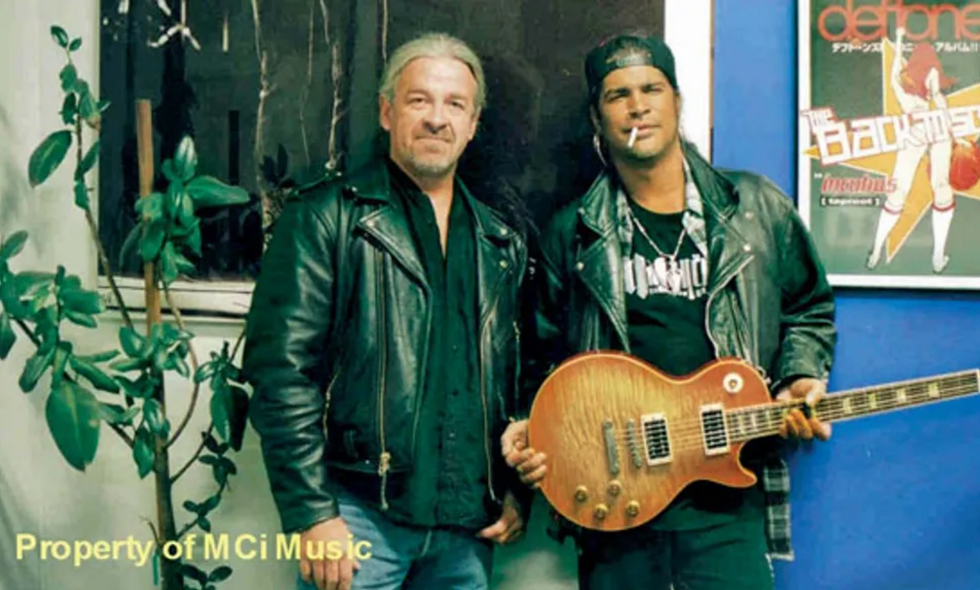
In this photo taken in 2001, Luthier Peter "Max" Baranet (left) stands with Slash and the Les Paul
replica he built for the gunslinger.
Photo courtesy of Peter Baranet
Allegedly, Slash obtained a third replica shortly after recording Appetite for Destruction. According to some, he obtained a second Derrig model. Others claim he got another Baranet instrument.
"Through Howie, Max was made aware that Slash needed a Les Paul and he needed one in a hurry," Rist says. "And it was mainly, from everything I know, for the purpose of another touring backup." Although it cannot be confirmed, Slash is presumed to still own that third replica.
Ultimately, some of the arguments surrounding these three replicas may never be solved. Short of getting Slash, the luthiers, and the guitars all in the same room and subjecting them to CSI-level scrutiny, some definitive answers simply cannot be had. In the absence of such hard data, the topic will continue to be passionately debated. One internet message board features an epic 531-post argument that spans three years— and people continue to post on the subject to this day!
While some observers may feel this level of fanatical discourse is a waste of time, it's what true believers do. They staunchly defend their interpretation of the myth or legend. At this very moment, some academic in a college classroom is surely arguing over the true historical figure that served as the inspiration for King Arthur. The Slash Les Paul replica debate simply features more volume.
Although Slash might see it differently, he undoubtedly fulfills Campbell's role of the hero who reinterprets a tradition and makes it valid for a current era.
During the early '80s, pointy guitars with whammy bars and slick paint jobs were required equipment for any aspiring rocker. Slash's bluesy, more straight-ahead rock 'n' roll riffs and leads on Appetite for Destruction swung the spotlight back on Les Pauls, which had been pushed to the side since the '70s heyday of Led Zeppelin and other LP-slinging bands.
"Back in the '80s, the Burst market was dead," says Baranet. "I used to go to the guitar shows in Texas every six months. I've got pictures from '88 of rows and rows of Bursts priced around seven to ten grand, and nobody was buying. When Guns N' Roses broke, Slash was playing a Les Paul in those three videos in constant rotation on MTV." That exposure attracted international collectors who scooped up Les Pauls, making them scarcer domestically. Accordingly, prices escalated.
"Slash playing Les Pauls was what kickstarted it," Baranet continues. "It's kind of funny, because he was playing replicas at the time, yet he kicked off the real Burst market, as well as the reissue and historic market that followed later."
While the truth of Slash's Les Paul arsenal may never be known, the fact is that guitarists and music lovers will always revere these iconic instruments. And they will always be fascinated by the fine details of the axes.
"To put it in an almost philosophical sense, it puts them closer to god," Rist says. "Especially if you take a look at Slash: He was a kid with an undying belief that he would make it, and now he's turned into a huge star. So you have all these people who wished they could get into that kind of position. They dream of it, but they'll never get there. Sometimes the closest people can get to that place is just talking about it."
Yes, Rist's assertion is a tough one to argue with. Talk of this hero who found iconic implements to complete a quest—and create a legend—truly is bound to continue from this generation and into subsequent generations as long as guitarists dream of ascending from musical mortality and entering the pantheon of guitar gods.
The Reality of Replicas

Undoubtedly, major guitar manufacturers like Gibson, Fender, and Ibanez view any instrument produced by an unofficial source to be counterfeit. And legally that's certainly true. But the handmade replica culture is not the same thing as some unsuspecting musician getting ripped off. Instead, all parties involved (except the major companies) agree that this can be an honorable transaction among consenting adults—one that involves high-quality instruments.
"Keep in mind that a guitar builder is very similar to an artist," says Roman Rist. "For an artist to pull off a convincing Picasso means he has arrived. It is not about passing off a fake. Rather, it's a way of saying 'Hey, this is my business card. If I can do this, I can do just about anything.'"
Some replica builders who did not want to be identified in this story even have relationships with the companies they're copying. They might do custom work for those manufacturers or help out in a pinch. Replicas are frequently of such stellar quality that they command high prices on the vintage market to this day.
"The last nice Max-made Les Paul that I know of changed hands for $45,000," says Howie Hubberman. Baranet himself won't confirm this, but when offered a range of $35,000 to $50,000, he says, "They've resold much higher than that."
Ironically, some replica builders are so respected that other people copy their work.
"There are more forgeries of my stuff than my replicas of the corporate stuff," Baranet laughs.
Other Legendary Guitars Shrouded in Mystery
Slash's Appetite for Destruction Les Pauls are not the only instruments open to speculation, conjecture, and controversy. The beat-to-hell, red-and-white-striped "Frankenstrat" that Eddie Van Halen made famous is a mutt of various components. Depending on who you believe, the body is a Warmoth, Fender, or Charvel. Kramer stepped in and made similar instruments for the guitar slinger in the early '80s, the most famous being the 5150 guitar with a hockey-stick-style headstock. Many fans confuse the Frankenstrat with the Kramer 5150. The high-end EVH-branded replicas of the Frankenstrat (right)—which are made by Fender and sold under the Frankenstein model name—further complicate the discussion.
George Lynch's skull-and-bones guitar is another oddity. Nicknamed "Mom," the highly carved instrument played by the shredder in such Dokken videos as "Dream Warriors" carried a misleading nameplate. The guitar was actually built by J. Frog. However, when he got the instrument Lynch had recently started a relationship with ESP Guitars, so he slapped an ESP sticker on the headstock before using it in the band's videos.
[Updated 11/10/21]
